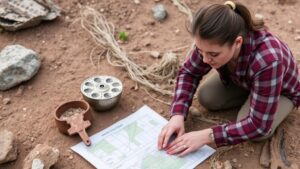Techniques for Identifying Hidden Compartments in Historical Buildings or Ruins
Techniques for Identifying Hidden Compartments in Historical Buildings or Ruins
Hidden compartments within historical buildings or ruins can unlock significant insights into the past, revealing details about architectural practices, usage of space, and even socio-economic conditions of earlier inhabitants. Identifying these concealed areas is a multi-faceted challenge requiring a blend of art, science, and technology. This article explores various techniques used by archaeologists, historians, and architectural conservators in the quest to uncover these clandestine spaces.
1. Visual Inspection and Architectural Analysis
The first step in identifying hidden compartments often involves meticulous visual inspection. Trained professionals utilize both experience and intuition to spot irregularities in wall structures, flooring, and ornamentation that may indicate concealed spaces. Architectural analysis focuses on historical building styles and construction techniques that may reveal hidden compartments.
- Tool Marks and Joints: Examination for unusual tool marks or inconsistencies in jointing can suggest that walls were altered or compartments were sealed.
- Architectural Features: Hidden doorways or false walls may be disguised within architectural details such as moldings or paneling.
For example, during the restoration of the ancient Roman villa at Oplontis, archaeologists noted discrepancies in wall thickness, leading to the discovery of a previously unknown storage chamber.
2. Material and Structural Analysis
Understanding the types of materials used in construction can provide clues regarding hidden compartments. By analyzing the age, source, and type of the materials employed, researchers can potentially date alterations or hidden modifications.
- Thermal Imaging: This non-invasive technique uses infrared cameras to detect temperature differences in building materials, which may signify hidden spaces or voids.
- Radar Technology: Ground Penetrating Radar (GPR) allows archaeologists to visualize sub-surface structures, making it possible to identify voids or chambers beneath floors or within walls.
An instance of this technique in action occurred during investigations at the HMS Victory, where GPR was utilized to map existing walls and floorboards, revealing evidence of additional compartments.
3. Historical Documentation and Contextual Analysis
Reviewing historical documents, such as blueprints, construction records, or architectural treatises, can yield critical information about the intended layout of a building, which may include hidden compartments.
- Old Maps and Plans: Analyzing historical maps can provide insights into modifications over time, indicating where hidden spaces might exist.
- Archaeological Reports: Previous archaeological investigations may hold clues if they noted irregularities or unexplored areas.
For example, a thorough review of texts from the medieval period has led to fruitful discoveries in cathedrals, revealing concealed chapels that were not documented in later architectural surveys.
4. Excavation and Site Surveys
When other techniques point to the potential existence of hidden compartments, controlled excavation may be necessary. This method relies on precision and caution to avoid damage to underlying structures.
- Stratigraphic Excavation: Layers of soil and building materials are meticulously recorded to understand construction phases and the potential for hidden compartments.
- Site Surveys: Systematic surface surveys can identify artifacts, features, and even ground disturbances that suggest underground compartments.
An exemplary case is the excavation at Pompeii, where layers of ash revealed numerous hidden spaces that were previously obscured but yielded significant artifacts showcasing daily life and rituals.
5. Modern Technology and Digital Reconstruction
Emerging technologies have transformed the identification of hidden compartments, offering innovative tools that enhance traditional methods. Digital reconstruction techniques utilize 3D modeling to visualize previously unseen structures.
- LIDAR (Light Detection and Ranging): This aerial laser scanning technology enables detailed surveys of building exteriors that can expose hidden architectural features.
- 3D Scanning: Ground-based scanners create detailed models that can help to visualize hidden compartments in three dimensions.
For example, the use of LIDAR has been instrumental in revealing extensive hidden features within the ruins of Angkor Wat, where dense vegetation previously obscured architectural elements.
Conclusion
Identifying hidden compartments within historical buildings or ruins requires an interdisciplinary approach that combines visual inspection, material analysis, historical research, excavation, and modern technology. Each technique offers unique insights that can unveil the secrets of the past, presenting a more comprehensive understanding of historical architecture and its cultural significance. The collaboration among architects, archaeologists, and historians is crucial in preserving these findings for future generations. By continually developing and integrating new technologies and methodologies, we can ensure that the stories held within these hidden compartments are brought to light and appreciated.
